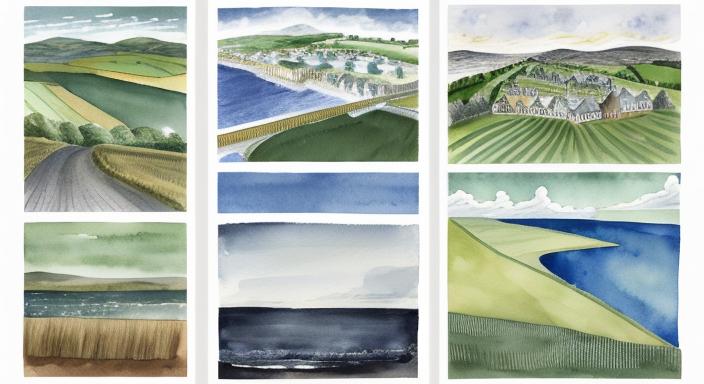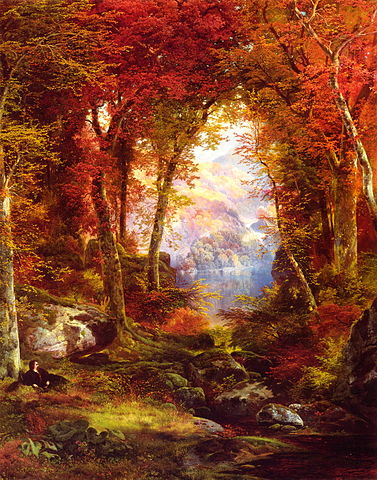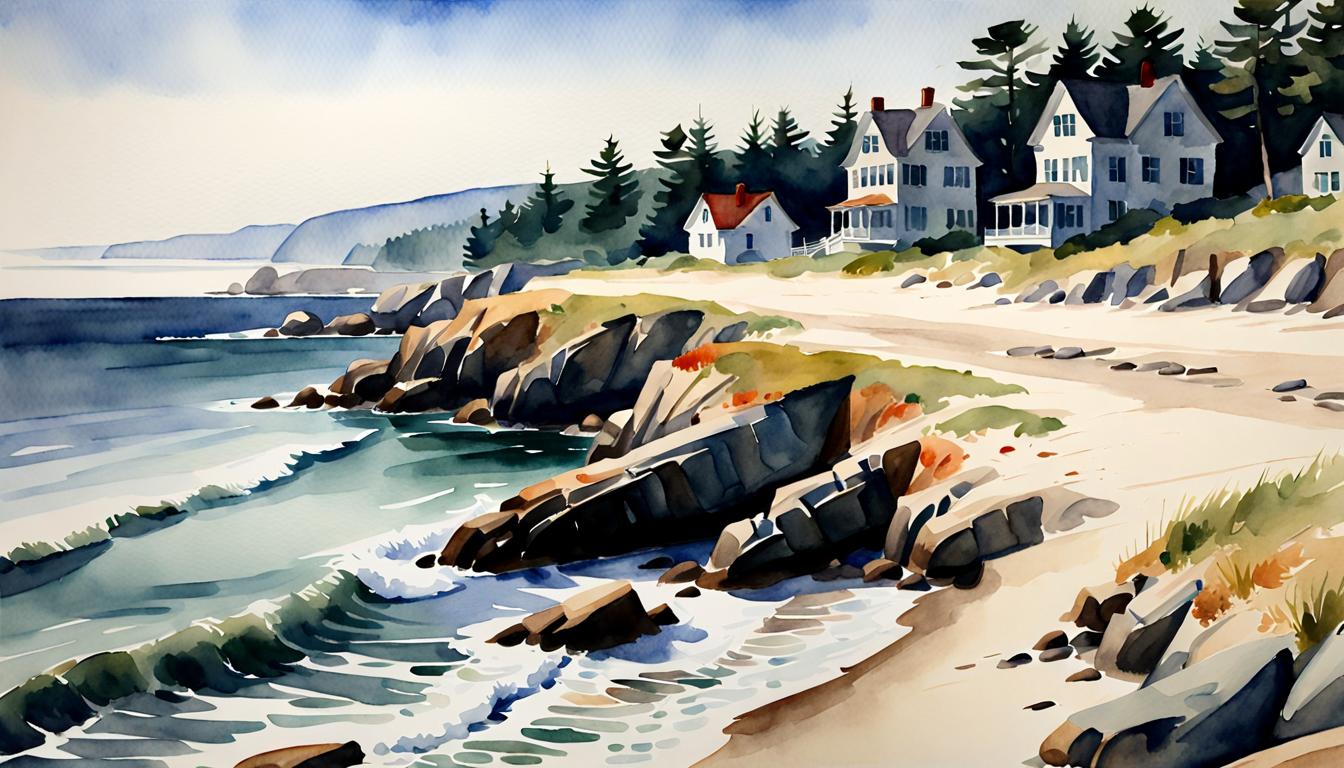Step into the world of Camille Pissarro watercolors: where light dances on landscapes, and everyday scenes shimmer with Impressionist charm. Pissarro, a founding figure of the movement, wasn’t just a master of oil on canvas. His watercolors capture fleeting moments with a vibrancy that continues to enthrall art lovers today. Dive deeper and discover the magic of Pissarro’s watercolors, from rural tranquility to bustling cityscapes, and explore how they embody the essence of Impressionism.

An Introduction to Camille Pissarro
Born in the Danish West Indies in 1830, Camille Pissarro moved to Paris in his youth, where he became a foundational figure among the Impressionists. His commitment to capturing rural and urban landscapes through unique perspectives and techniques has left an indelible mark on the art world. Pissarro’s watercolors, though less discussed than his oils, showcase his versatility and keen observational skills.
The Charm of Watercolors
Watercolor painting, with its delicate and translucent qualities, offers a different set of challenges and rewards compared to oil painting. Pissarro’s watercolors often emphasize spontaneity and lightness, capturing fleeting moments with a soft, yet vibrant touch.
Iconic Camille Pissarro Watercolors

- Landscape with House in the Woods in Saint Thomas, Antilles (c. 1854–55) – Private collection
- This watercolor showcases a serene wooded landscape with a house tucked away among the trees, reflecting Pissarro’s early fascination with the natural beauty of Saint Thomas. The composition emphasizes the lush tropical environment and the tranquility of the setting.
- Village at the Foot of a Hill in Saint Thomas, Antilles (c. 1854–55) – Private collection
- This piece depicts a quaint village nestled at the base of a hill, capturing the essence of rural life in Saint Thomas. Pissarro’s use of watercolor brings out the vibrant colors and the idyllic nature of the Caribbean landscape.
- Mountain Landscape at Saint Thomas, Antilles (unfinished) (c. 1854–55) – Private collection
- An unfinished watercolor that reveals Pissarro’s process and allows viewers to see the artist’s initial sketches and color applications. The piece portrays the dramatic mountainous terrain of Saint Thomas, highlighting the island’s rugged beauty.
- Woman Carrying a Pitcher on Her Head (1854–55) – Private collection
- This watercolor illustrates a local woman balancing a pitcher on her head, a common sight in the daily life of Saint Thomas. Pissarro’s attention to detail and his use of light and shadow bring a sense of realism and movement to the scene.
- Creek with Palm Trees (1856) – National Gallery of Art, Washington D.C.
- A serene depiction of a creek lined with palm trees, this watercolor captures the tranquil and lush environment of Saint Thomas. Pissarro’s delicate brushwork and use of vibrant greens and blues convey the tropical atmosphere.
- Antilian Landscape, St. Thomas (1856) – Private collection
- This watercolor presents a broad view of the landscape in Saint Thomas, featuring rolling hills, dense vegetation, and clear skies. The composition reflects Pissarro’s deep appreciation for the natural beauty of the Caribbean.
- Two Women Chatting by the Sea (1856) – National Gallery of Art, Washington D.C.
- This piece portrays two women engaged in conversation by the seaside, with the vast ocean stretching out behind them. The watercolor technique beautifully captures the light and color of the sea and sky, adding depth and vibrancy to the scene.
- A Creek in Saint Thomas, Antilles (1856) – Private collection
- Another tranquil scene of a creek in Saint Thomas, this watercolor highlights the lush greenery and calm waters of the island. Pissarro’s use of watercolor brings out the subtleties of light and shadow, creating a peaceful and inviting landscape.
- Laundress on the Banks of the River (c. 1856) – Private collection
- This work depicts a laundress at work along the riverbank, providing a glimpse into the daily life and labor of the local people. Pissarro’s attention to the figure’s posture and the surrounding environment adds a sense of realism and intimacy.
- The Banks of the Oise near Pontoise (1873) – Indianapolis Museum of Art
- Although primarily known as an oil painting, this work showcases Pissarro’s skill in capturing the French countryside. The scene depicts the banks of the Oise River near Pontoise, with detailed attention to the natural landscape and the effects of light on the water.

These watercolors exemplify Camille Pissarro’s early work and his ability to capture the essence of the Caribbean landscape and its people, as well as his later development in depicting rural French scenes.
Techniques and Innovations in Pissarro’s Watercolors
Pissarro’s approach to watercolors was both traditional and innovative. He often used the following techniques:
- Wet-on-Wet: This technique involves applying wet paint onto wet paper, creating soft edges and blending colors seamlessly.
- Dry Brush: Pissarro used a dry brush to add texture and detail, particularly in his depictions of foliage and buildings.
- Layering: He built up layers of watercolor to achieve depth and complexity in his compositions. This method allowed him to create rich, vibrant scenes that captured the essence of his subjects.
A Closer Look at His Artistic Process
Pissarro often started his watercolors with a light pencil sketch, outlining the main elements of the composition. He then applied washes of color, gradually building up the intensity and detail. This method allowed him to maintain the spontaneity and freshness that are hallmarks of his watercolors. One art critic observed: “Pissarro’s watercolors reveal his ability to convey atmosphere and mood with minimal means, His mastery of the medium is evident in the delicate yet expressive quality of his brushwork.”
The Legacy of Pissarro’s Watercolors
While Pissarro is primarily known for his oil paintings, his watercolors have gained increasing recognition in recent years. They offer a more intimate glimpse into his artistic vision and process, showcasing his ability to capture the world around him with sensitivity and precision.
Influence on Contemporary Artists
Pissarro’s watercolors have inspired numerous contemporary artists. His innovative techniques and keen observational skills continue to influence painters who seek to capture the fleeting beauty of everyday life.
Exhibitions and Collections
Many of Pissarro’s watercolors are housed in prestigious museums and private collections around the world. They are frequently featured in exhibitions, allowing audiences to appreciate the breadth and depth of his work.
Notable Collections Featuring Pissarro’s Paintings
| Museum | Location | Notable Watercolor Works |
|---|---|---|
| The Metropolitan Museum of Art | New York, USA | “The Boulevard Montmartre at Night” |
| Musée d’Orsay | Paris, France | “Boulevard des Italiens, Morning, Sunlight” |
| The National Gallery | London, UK | “The Garden at Eragny” |
| The Getty Center | Los Angeles, USA | “Peasant Woman Binding Sheaves” |
| The Art Institute of Chicago | Chicago, USA | “View from My Window, Eragny” |
Personal Reflections
A Personal Connection to Nature
Pissarro’s watercolors often reflect his deep connection to nature. He spent many hours outdoors, sketching and painting the landscapes around him. His home in Eragny provided endless inspiration, and he took great pleasure in capturing its beauty through his art.
“Painting outdoors allows me to breathe in the scenery, to feel the light and wind,” Pissarro once remarked to a friend. “It’s an experience that infuses my work with life.”
A Mentor to Many
Pissarro was not only a prolific artist but also a mentor to many younger painters, including Paul Cézanne and Georges Seurat. His watercolors often served as teaching tools, demonstrating his techniques and approaches to capturing light and color.
A Family Affair
Art was a family affair for Pissarro. His children, particularly Lucien and Georges, also became accomplished artists. They often accompanied him on painting excursions, learning from his expertise and sharing in his passion for capturing the natural world.
Conclusion
Camille Pissarro’s watercolors offer a unique window into his artistic practice and vision. These works, characterized by their spontaneity, delicate brushwork, and vibrant use of color, continue to captivate audiences around the world. Whether depicting the bustling streets of Paris or the tranquil countryside of Eragny, Pissarro’s watercolors reveal a profound sensitivity to the world around him and a mastery of the medium that remains influential to this day.
By celebrating these watercolor works, we not only honour Pissarro’s legacy but also gain a deeper appreciation for the beauty and complexity of his art. As we continue to explore and exhibit his watercolors, we ensure that future generations can experience the magic of Pissarro’s vision and the timeless quality of his work. An art historian observed: “Camille Pissarro’s watercolors are a testament to his enduring genius, They remind us of the power of art to capture the fleeting moments of life and transform them into lasting beauty.“


